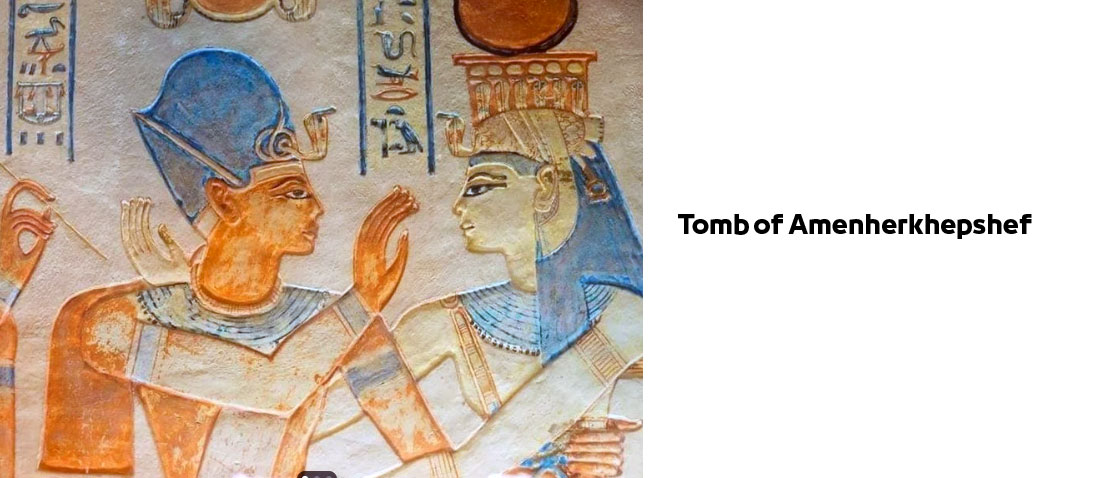Tomb of Amenherkhepshef | KV13 “, son of Ramesses IX, an, son of Ramesses VI” in Valley of the Kings, Luxor, Egypt – Egyptian Tombs
Facts about Tomb No. 13, son of King Ramses III and Prince Mentuharkhepeshef, son of King Ramses VI of the Twentieth Egyptian Dynasty in The Ramesside Period, The New Kingdom of Egypt, and the history of building Pharaonic tombs in ancient Egyptian civilization, and more: Tomb design, visiting hours, and entrance ticket prices…
It is a tomb called No. 13, and is known worldwide by its title and location, the Valley of the Kings in Egypt. This tomb was built to bury the nobleman Bay since the end of the Nineteenth Dynasty. Learn more information about this tomb in the history of the Pharaonic civilization “Ancient Egypt History“..
Tomb of Amenherkhepshef Facts
Prince Amun-Her-Khepshef is the son of King Ramses III, the most famous of the Egyptian Pharaohs kings. He has a funerary temple in the Karnak Temple Complex, the Temple of Medinet Habu, and the Tomb of King Ramesses III | KV11.
The prince was given a number of titles, including the title of the King’s Right Hand Fan Bearer..
He would come carrying a large fan made of ostrich feathers..
A group of appearances appear in the tomb of King Ramesses III of Prince Amun..
The nobleman “Bay” was a person from the high-ranking ruling families in ancient Egypt “Ancient Egyptian Government“, and the purpose of building this tomb was to bury him in it..
The nobleman “Bay” was executed during the reign of King Siptah of the Nineteenth Dynasty of Egypt and was not buried there..
Therefore, the tomb of Amun-Herkhepeshef was used to bury Prince Amun-Herkhepeshef and was also used to bury Prince Mentu-Herkhepeshef, son of King Ramesses IX..
The tomb was discovered by Egyptology and archaeologist Hartwig Artenmüller..
No Funerary Equipment furniture or pharaonic Ancient Egyptian Coffins belonging to Bay was found, although it was his tomb from the beginning..
specifications
The tomb contains a group of inscriptions that come in distinctive colors to indicate the length of Sculpture in Ancient Egypt.
The prince died so young that pictures of him with a side lock of hair were found, indicating the development of Mummification in ancient Egypt.
That lock of hair is proof that he is still young..
One of the pictures that comes inside the tomb is a picture of the prince holding a long ostrich feather..
There are also other images of King Ramses III presenting his son to the Egyptian deities – Ancient Egyptian gods and Goddesses, as in the Ancient Egyptian religion.
In addition to the presence of another group of pictures during the performance of King Ramses III’s religious rituals..
Unlike almost all tombs, the owner of the tomb of Amun-Her-Khepsef is the one who performs these rituals, indicating the development of Architecture in ancient Egypt.
However, this difference may be justified by the young age of Prince Amun-Her-Khepshef..
The tomb consists of a sloping staircase leading to a main chamber with another side chamber..
The long hall ends with a burial chamber. It is noted that there is a group of unfinished rooms, which are rooms for offering sacrifices and Food in ancient Egypt.
The first chamber contains a group of images of the prince and king Ramses III with the gods..
The images come in a range of bright colours, and the gods mentioned in these drawings include God Ptah and God Isis.
There are also pictures of King Ramses embracing a god, but it is not clear who exactly the god is..
Note: Facts and secrets of the history will be added soon…
Hurghada Excursions Lovers, Best Travel Agency in Hurghada to provide daily tours to visit the Tourist attractions of Luxor by Hurghada to Luxor Tours and Hurghada to Pyramids Trips. Book online when you come to Hurghada, El Gouna, Sahl Hashish, Makadi Bay, Soma Bay, Egypt Tours Packages.
